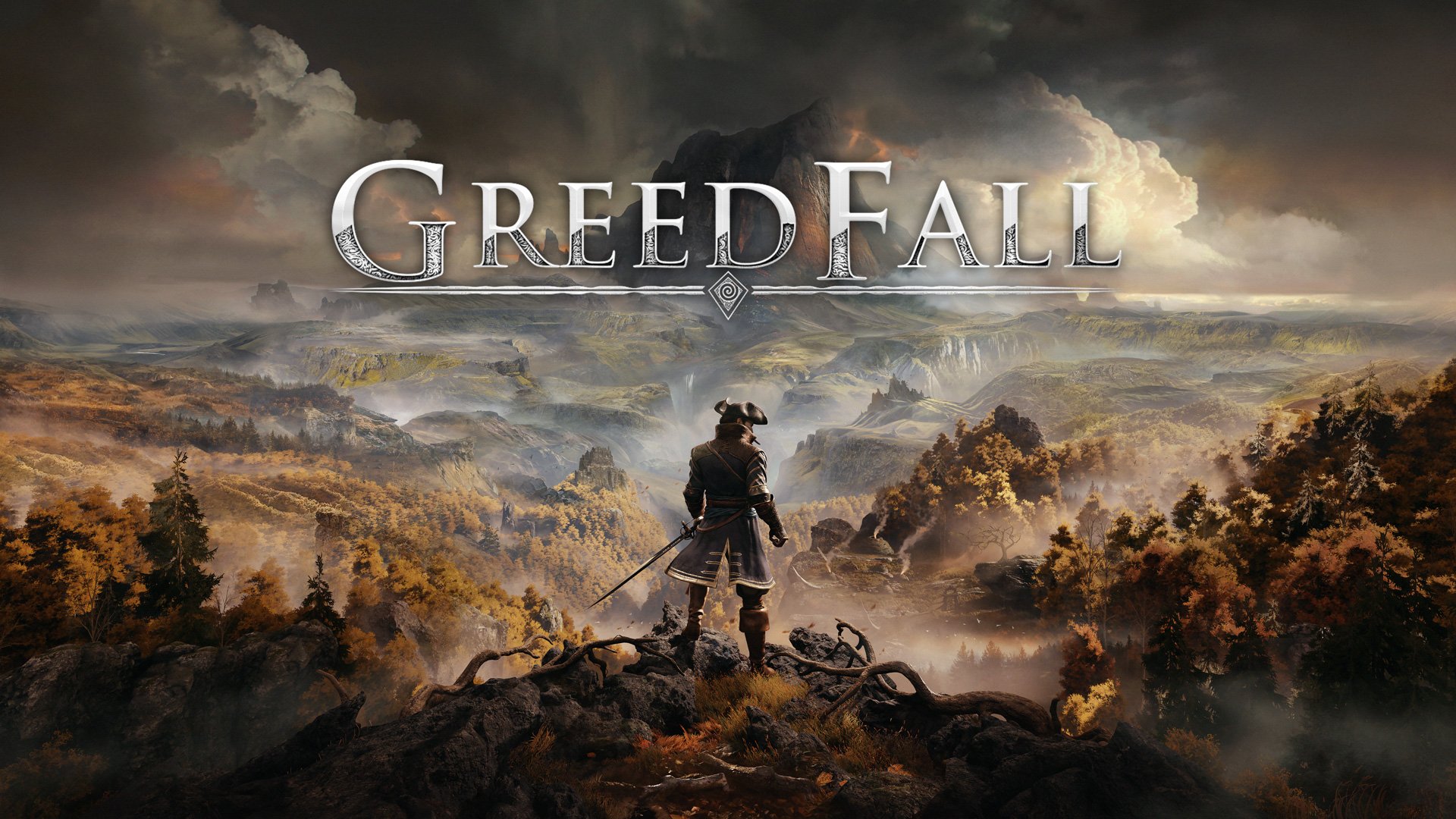
Spiders is a company I’ve always been rooting for. This small developer’s games are notoriously janky and buggy, but underneath the numerous flaws you can find all the necessary ingredients required to make a memorable title. Their games often feature interesting worlds or ideas that are just shy of reaching their full potential, and I’ve always felt that it was just a matter of time before Spiders finally got their formula right. When playing a game by Spiders, you can’t help but wonder what they could produce if given more time and resources. My soft spot for the company, and the desire to see them finally deliver a truly great RPG, is a big part of why GreedFall clawed its way up my list of most anticipated game releases of 2019. While GreedFall has plenty of Spiders’ signature jank and cut corners, it’s also a huge step up from their previous games.
GreedFall
Publisher: Focus Home Interactive
Developer: Spiders
Platforms: Windows PC (reviewed), PS4, Xbox One
Release Date: September 9th, 2019
Players: 1
Price: $49.99
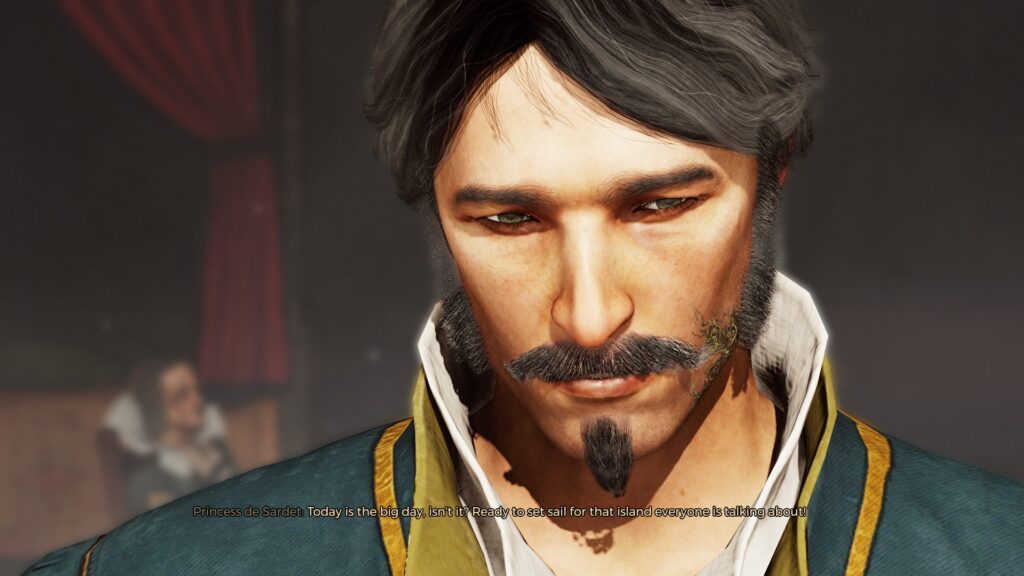
GreedFall is set in a fantasy interpretation of the 17th century. The game’s version of Europe is being ravaged by a mysterious and deadly plague called the Malichor. Worse still, the nations of Teleme and the Bridge Alliance are locked in a bitter and devastating war. However, an exotic and mystical island named Teer Fardee has recently been discovered. Teer Fardee is a wild and largely untouched land that is rich in natural resources and home to numerous flora and fauna that don’t exist anywhere else. The natives also wield potent magic and have a deep connection with the bizarre, lumbering creatures that call the island home.
The game is set around 15 years after the first colony was established on Teer Fardee by the Bridge Alliance. Teleme and the Congregation of Merchants soon followed, and all three major powers hope to exploit the island’s resources. Many also believe that a cure for the Malichor could be discovered by studying the island’s unique plant and animal life, and learning more about the mystical powers of the natives and the gods they worship.
You play as De Sardet, a legate from the Congregation that has been sent to Teer Fardee alongside your cousin, Prince Constantin. Your cousin has been appointed governor of New Serene, the Congregation’s colony on Teer Fardee. As legate, your mission will revolve around negotiating with the various factions on Teer Fardee and trying to maintain the fragile peace on the island. That won’t be easy, as the war between Teleme and the Bridge Alliance threatens to spill over on Teer Fardee, and both factions are constantly pressuring the Congregation to end their neutrality and join one side or the either. As you’d imagine, the natives of Teer Fardee also aren’t too thrilled about having foreigners around destroying, exploiting, and colonizing their ancestral homeland.
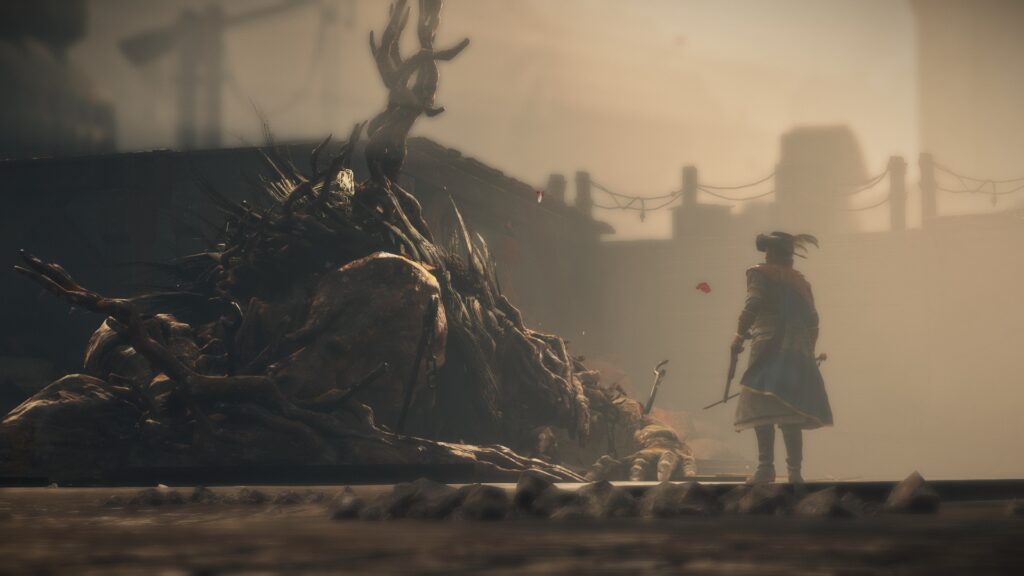
While you’ll certainly be doing your fair share of fighting on Teer Fardee, many of the game’s quests will center on negotiation. You are an ambassador after all, and the volatile situation on Teer Fardee means that words and bribery are often the most sensible weapons in your arsenal.
The questing and story are definitely GreedFall‘s biggest highlights. Most quests have multiple, mutually exclusive paths you can take based on your choices and playstyle. No quest is truly straightforward, and they all pack loads of plot twists and difficult choices that you might not expect when issued a task that seemed fairly easy at first glance.
In addition to the solid writing, the voice acting is also fairly decent. The cast of GreedFall probably won’t win any awards for their performances, but none of the voice acting stood out as particularly egregious. The same can’t be said of the character model’s lip syncing and movement during dialog, however, which often looks unnatural and stiff.
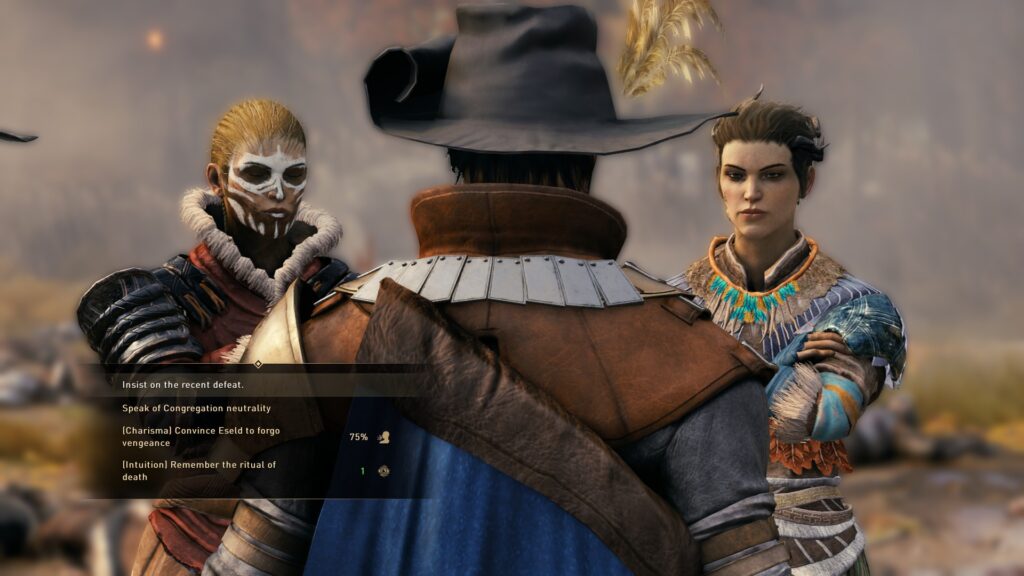
While the quests are all engaging and well-written, one downside is that many of them are full of backtracking and traveling. Since you are essentially an intermediary trying to resolve issues between rival factions, you’ll often find yourself negotiating a deal, being sent back to your original quest giver, being given a counter offer, and then returning to report your results. You will become intimately familiar with the game’s fast travel system long before you reach the end of GreedFall‘s 40-50 hour long storyline.
The island of Teer Fardee itself is essentially several self-contained hub cities with about a dozen or so equally self-contained chunks of wilderness. The game tries to give the illusion of being open world, but its closer to an older BioWare RPG, where you’ll be traveling between fairly large areas interspaced with loading screens.
The cities and towns are probably the most disappointing part of GreedFall‘s world, and the game’s fairly modest budget is very apparent here. Tons of buildings, rooms, and other assets are reused, to the point that faction-specific dwellings like the Coin Guard’s barracks and taverns are completely identical in every city. Even the palaces of New Serene, Teleme, and Hikmet are the same copy-pasted layout, and use very similar décor. The only real differences in layout are what rooms are blocked off or otherwise inaccessible.
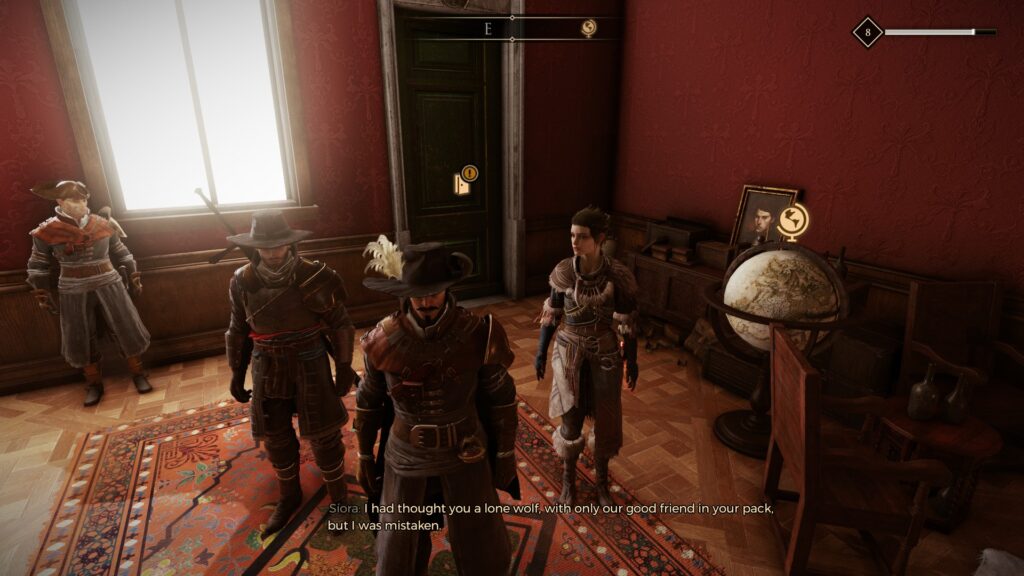
The civilian AI also fails to really make the cities feel like they are living, breathing worlds. Citizens will wonder around aimlessly, get stuck on terrain, or just stand around doing nothing a lot of the time. The AI don’t have daily routines or any real life to them. While its certainly convenient that the potion shop is open at 3 am, it kind of breaks the game’s feeling of immersion.
The AI also makes the game’s token stealth system more annoying than it should be. More than once I’ve been discovered because the AI randomly turned around, or worse, got stuck in an infinite loop where they were walking in circles or spinning in place.
The wilderness regions are much more interesting, and feature lots of hidden areas, loot, encounters with enemies, and many other places of interest. Each region will have some campsites to discover, which allow you to rest, switch out your party, store or retrieve items from your personal stash, talk with your companions, craft or upgrade items, and fast travel to other discovered locations.
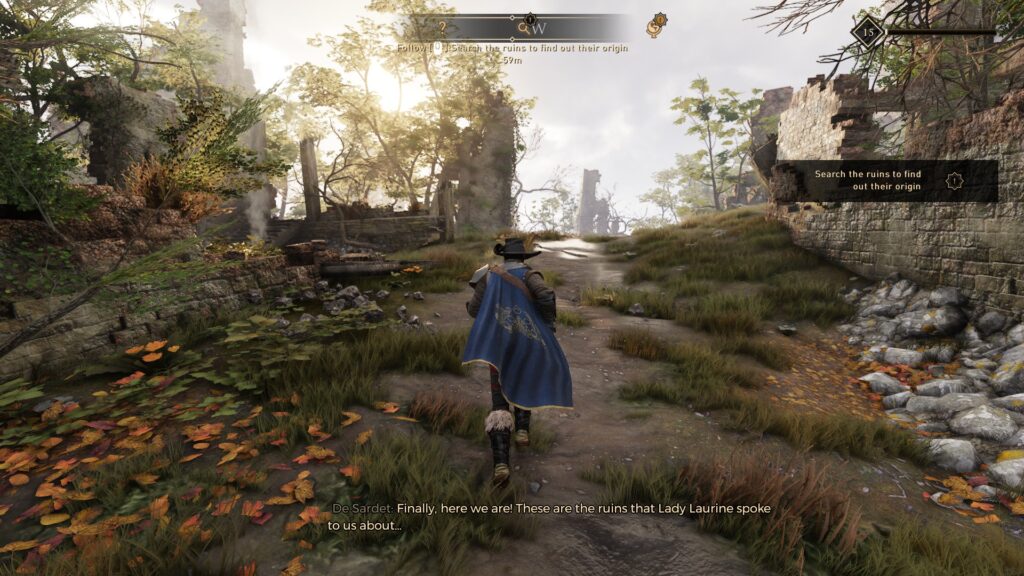
While you will see plenty of reused assets in the wilds of Teer Fardee as well, its much less noticeable and the sense of wonder that comes from finding out what each question mark on your map could be keep exploration compelling.
Many wilderness areas will also feature tough boss encounters with the mysterious giant guardians of the island, and you’ll find scattered outposts, ancient ruins, skill point shrines, and native villages that might offer side quests or legendary loot.
Many of the game’s hidden areas require a skill check as well. Maybe you’ll find a narrow ledge that requires more points in Agility to cross, or a long gap that you’ll need higher Vigor to jump across. Some of these hidden areas might just be shortcuts around the map, but many can lead you to nice loot drops or alternate routes in a quest. In any case, you’ll probably find a number of places you’ll want to revisit once you get some more attribute points.
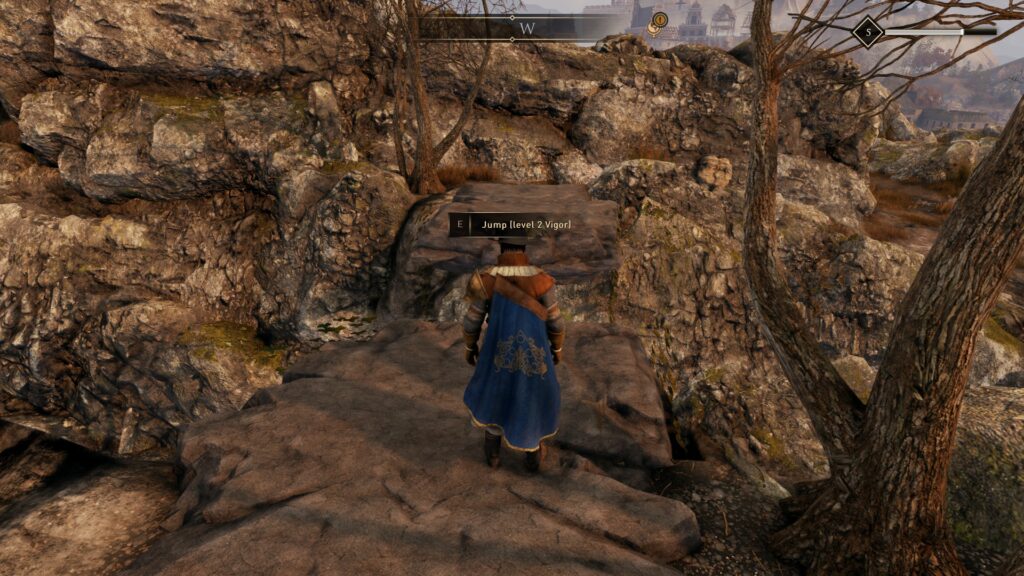
I’ve often seen people compare GreedFall to an older BioWare game, and that comparison is fairly accurate in many ways. During your journey, you’ll encounter a cast of interesting companions that will follow you around, help you in combat, and can be talked to in your downtime to build a stronger relationship with them. Your companions will often exchange quips with you and each other during quests, and may even interject in dialog.
These interjections can sometimes put you in a bad spot during negotiations, like if you have Siora with you and someone starts to badmouth the native tribes of Teer Fardee. How you handle these situations can alter your reputation with factions or your companions, and its actually possible to damage your relationship with a companion so thoroughly that they’ll abandon you. This never happened to me in my playthrough though; in my experience, you have to actively go out of your way to piss someone off to severely damage your reputation.
As your relationships grow, you’ll be approached by your companions with personal questlines. These are very similar to the loyalty quests in a Mass Effect game, and completing them can forge nearly unbreakable bonds. These questlines are multi-part and often require you to wait for things to advance before getting the next stage in the quest. You can also romance your companions, and like a BioWare game, you’ll be rewarded with some stiffly animated and rather cringy love scenes.
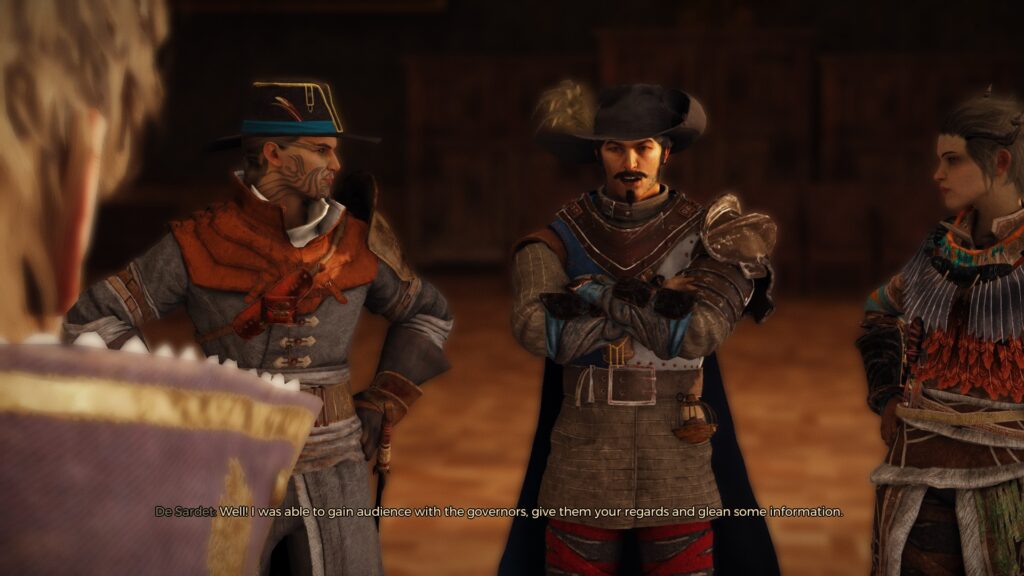
Questionably animated sex scenes aside, GreedFall‘s companions are all pretty likeable and come with some of the game’s more interesting quest chains. The way they interject into dialog and can potentially sabotage a negotiation means you have to put more consideration into who you bring with you. Even your favorite companion can potentially become a liability if you bring them to the wrong meeting, so learning their likes, dislikes, and personalities is key. Conversely, bringing along the right person at the right time could even unlock unique options in a dialog tree as you allow them to use their knowledge of a situation to make headway in an otherwise difficult conversation.
Unfortunately, you really don’t have any control over your companions. They don’t have any skill trees you can manually tweak, nor can you direct them in combat. All you can really do is equip them with gear, which can sometimes prove annoying since you have no direct control over where their skill points are going. I’m not entirely sure how companion leveling actually works in the game, just that occasionally they’ll suddenly reach the requirements for the piece of legendary gear you really wanted to give them about seven hours ago.
Fortunately, your own character building options are fairly solid. GreedFall doesn’t exactly have classes, and the game’s core combat mechanics encourage you to dabble in a few areas to compensate for inherent weaknesses in fighting styles. You have Skills, Attributes, and Talents to level up. Each level increase will give you a Skill point to spend, while Attributes and Talents happen every few levels.
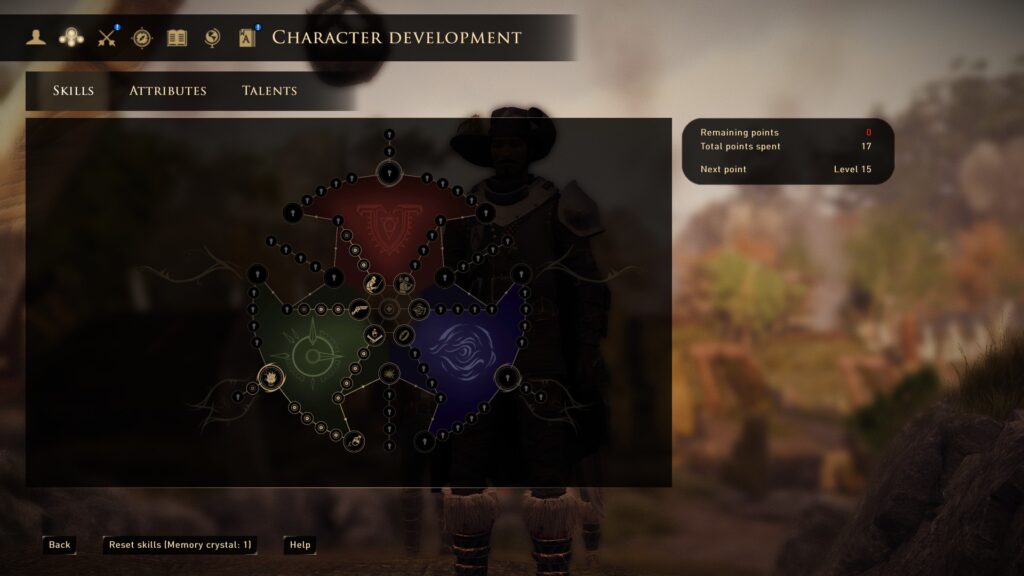
Skills are your combat abilities, and are roughly divided into Strength, Magic, and Technical. Most of the Skill tree consists of nodes that just give small upgrades, with every sixth node on a path giving a significant ability, like a new spell or attack type.
Attributes are divided into six paths that each contain five levels. Each Attribute increases your proficiency and stats in certain areas, like how Strength increases melee damage. Attributes also fill the role of gear requirements. You’ll often find really good gear that requires a certainly Attribute level to equip, and each Attribute governs a specific type of gear. For example, if you want to equip the best guns in the game, then you’ll need to focus on your Accuracy. These will also allow you to access hidden areas like I discussed earlier.
Finally, Talents are your noncombat abilities. There’s six of them, each of which contain three levels. These are things like Charisma, which will unlock new dialog options, or Science, which will allow you to craft higher level potions.
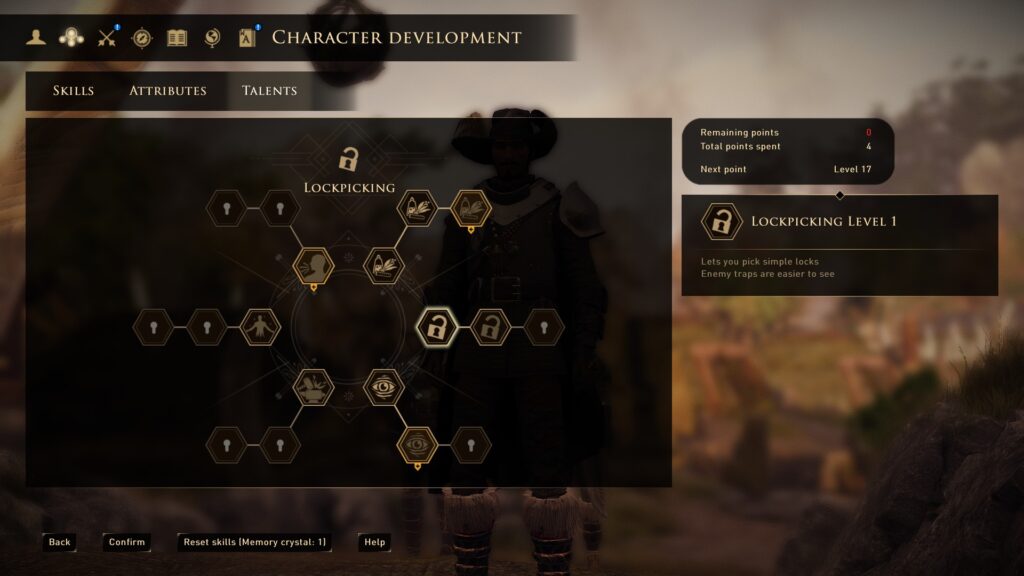
The game’s crafting system is fairly straightforward. You find a workbench and use ingredients gathered throughout Teer Fardee to make potions, traps, etc. You can also upgrade your weapons and armor. Anything above a green level rarity will have sockets that you can slot upgrades into.
If you have the requisite Craftsmanship skills, you can create some really powerful upgrades that can significantly improve your armor and weapons. Chest armor in particular can be upgraded with Talent bonuses. If you don’t want to focus on crafting then you can always visit a blacksmith, though relying on a smith costs a small fee on top of the material requirements.
The game’s character progression and crafting systems are all serviceable. It’s not the most deep or complex versions of these systems I’ve ever seen, but they get the job done well enough. As with many aspects of the game, the crafting UI could use some quality of life enhancements. If you ever find yourself having to craft items in bulk, you’ll find the lack of a proper quantity slider tedious. Selling and buying items in bulk is just as annoying.
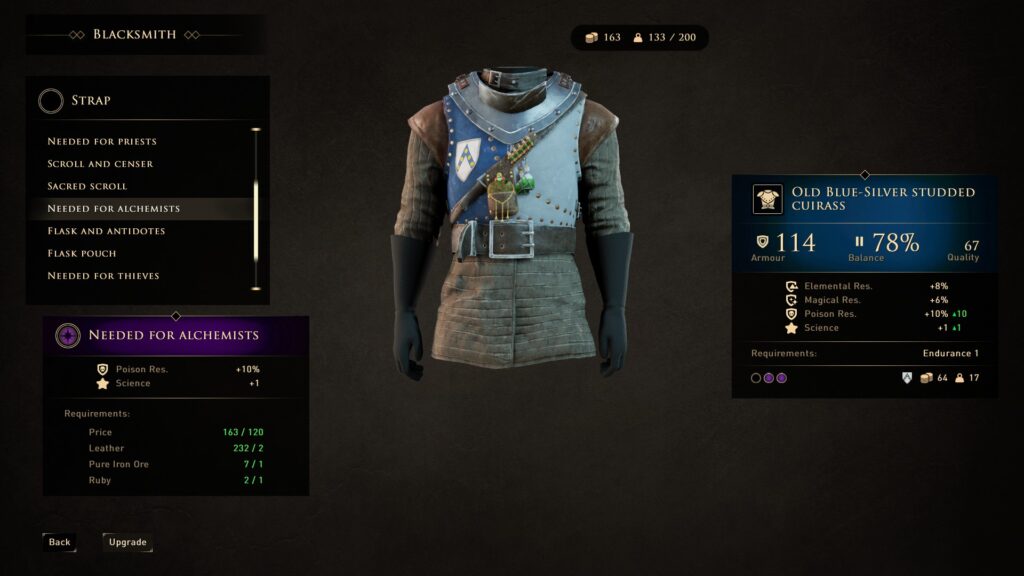
The combat is equally decent, if not particularly exceptional. It can even get pretty fun and engaging at times when you are facing particularly tough enemies. Combat consists of your standard selection of melee combos, blocks and parries, dodges, and the odd magic spell or two. Magic in the game is particularly big and flashy, but burns through mana extremely fast. This means that you can’t really make a pure mage character and will need to dabble in other areas.
Personally, I decided to focus on the Technical skills, which means firearms and traps. I quickly realized that traps are fairly useless though. They have small hitboxes, requiring you to lure the enemy into an extremely specific path to trigger them.
Luckily, one of the skills early on allows you to turn your traps into grenades, which is significantly more useful. No matter what style you choose though, you’ll always need to keep on your toes and get close to the action with a sword or axe from time to time.
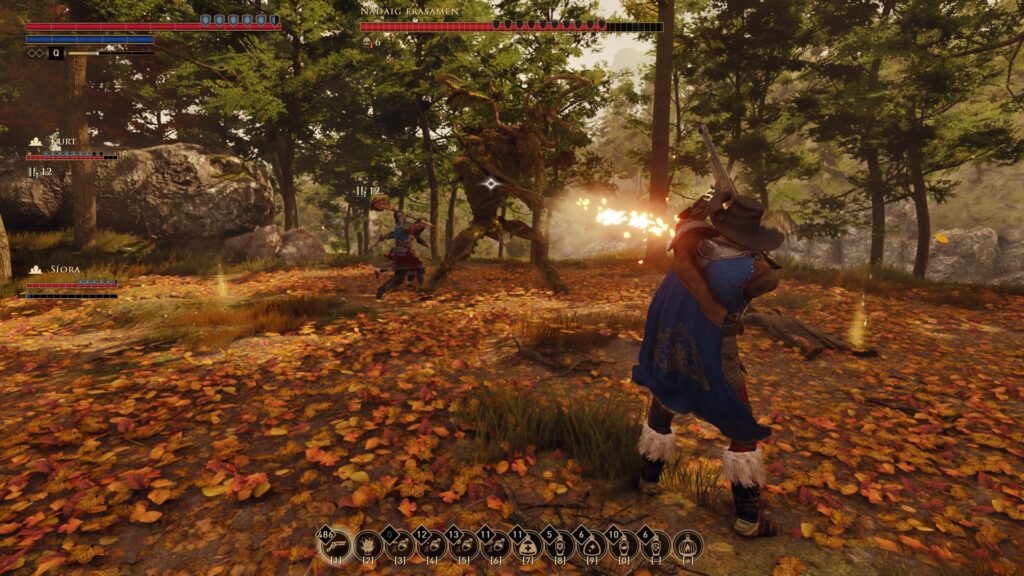
The combat’s core mechanics revolve around an armor system. Everyone, including yourself, will have several armor “pips” that will reduce incoming damage. You’ll need to either break the armor, or rely on things that bypass armor, to do any meaningful damage. Heavy weapons like hammers and two-handed axes tend to do decent armor damage, as well as many guns and explosives.
Magic, meanwhile, completely bypasses armor. No matter your ally composition and playstyle, you’ll want to make sure you have a weapon that focuses of armor damage and a weapon that focuses on physical damage if you want to get anywhere in the game’s more taxing combat encounters.
There’s also an adrenaline system that acts as a super move. You build adrenaline as you deal damage, and as the bar fills up, you can hit Q to deal more powerful attacks that expend adrenaline. Each skill path also has some big and flashy ultimate moves that require a full adrenaline bar to use. For the Technical-focused path I took, this meant an extremely powerful bomb that deals heavy damage and staggers enemies in a relatively large AoE.
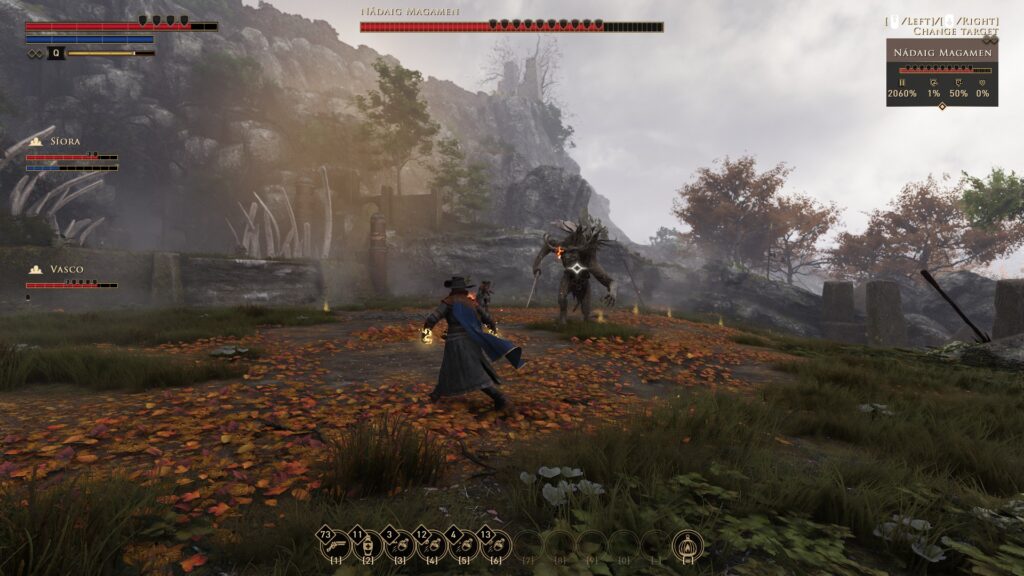
While the combat is all in real-time, there is a tactical pause menu that lets you quickly swap out skills or queue up a potion. Since the game allows you to set 12 hotkeys you probably won’t have to use it often, but its there if you need it.
As I said, the combat is serviceable enough. Its not super deep or tactical, but it has its moments. There really aren’t that many active abilities in the game, which definitely hurts combat variety and depth. Instead, GreedFall prefers to focus on a smaller number of skills and powers that you’ll gradually improve as you level up.
The biggest downfall of GreedFall‘s combat is probably the difficulty. Veterans of action-based RPGs will probably want to crank the difficulty up if you are looking for any sort of challenge. Once you get past the early stages of the game and begin to level up and get better gear, most encounters will quickly become a breeze. The only time you’ll start to break a sweat in the middle portion of the game is if you intentionally fight large groups of high level enemies, or during boss encounters.
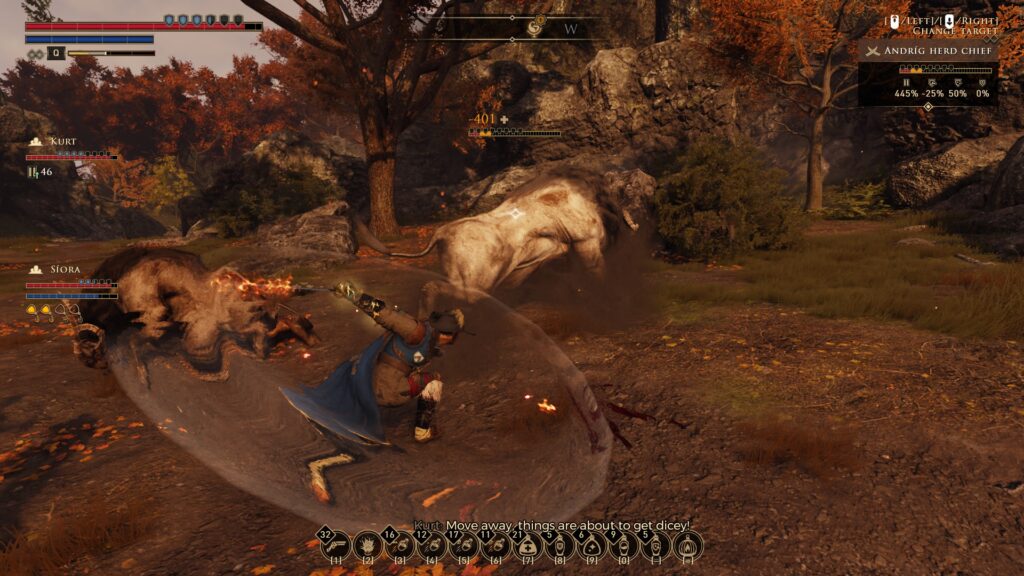
There’s some pretty cool creature designs scattered around Teer Fardee, but overall enemy variety is a bit on the sparse side. Be prepared to fight large bear-like creatures called Ulgs a lot, because they make up many of the mobs you’ll stumble across in the wilderness. You’ll also encounter a lot of fairly generic bandits and highwaymen that don’t put up much of a fight.
The combat’s sound assets are fairly good though, as are the environment’s ambient noises and the various bestial roars you’ll hear come from Teer Fardee’s wildlife. The game’s black powder firearms sound suitably powerful, and grenades are satisfying to throw into a group of enemies. The soundtrack is good as well, and meshes nicely with the setting and action on-screen. The music cues could use some work though, as the drum of the game’s combat music always starts whenever enemies are nearby instead of when you actually engage them.
On one final note, I’d like to mention that the game isn’t particularly well optimized. The game chugs on max settings at 1080p on my PC, rarely staying at 60 FPS for more than a few seconds, and often dipping into the 40s. While my rig is far from top of the line (1070 with an i7-8700), I wouldn’t expect a fairly budget RPG like this to perform as badly as it does. I’ve heard similar things from people with better machines than me, so be prepared to tweak your settings if you are on the middle to lower end of the hardware spectrum.
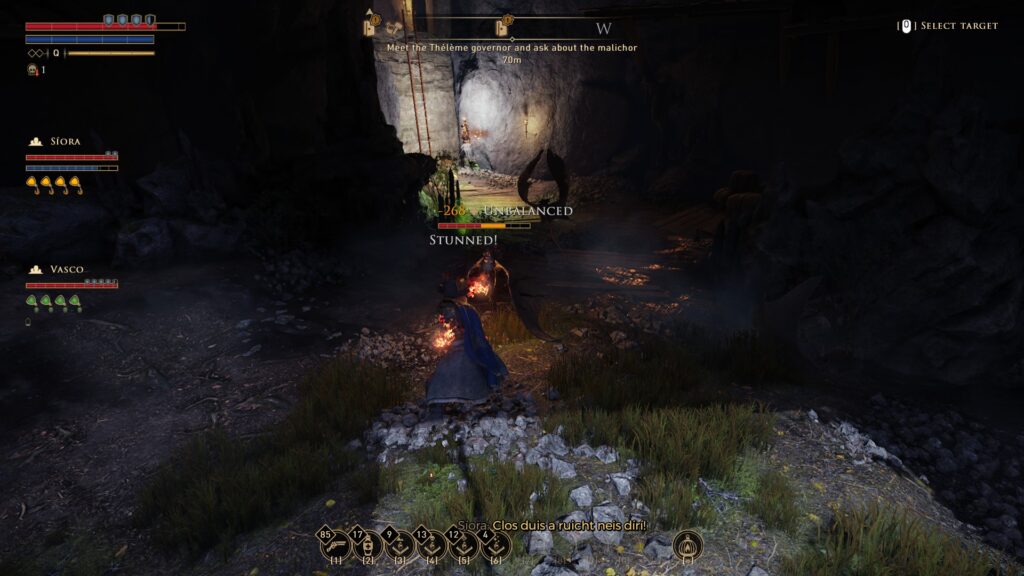
GreedFall isn’t a perfect RPG by any means. As with previous games from Spiders, it has its share of iffy animations, questionable UI, and merely serviceable mechanics. While it is leaps and bounds ahead of their previous games, you can still tell that its a budget RPG that probably could have spent a little more time in the oven.
But, at the same time, it offers an intriguing world to explore, some entertaining characters, and some really solid quests and writing. Despite its flaws, its probably one of the better BioWare-style RPGs we’ve had in some time, and I quite enjoyed it despite all my complaints.
If you go in expecting a budget RPG that had some corners cut here and there, then you’ll probably find a lot to like here as well. I feel like Spiders has finally discovered their niche with GreedFall, and with some more refinement, tweaks, and added depth, I think they will eventually have a winning formula for their next game.
GreedFall was reviewed on Windows PC using a review copy provided by Focus Home Interactive. You can find additional information about Niche Gamer’s review/ethics policy here.